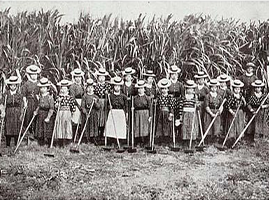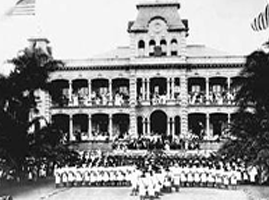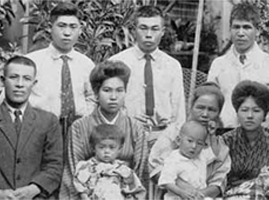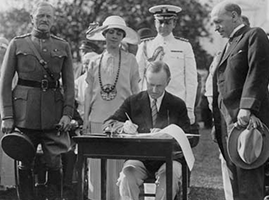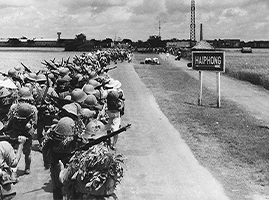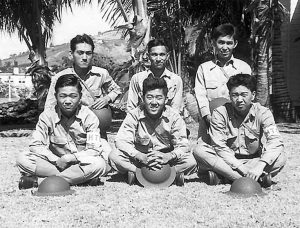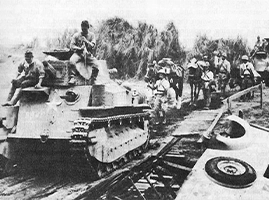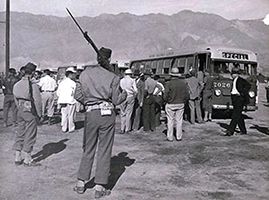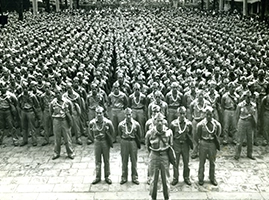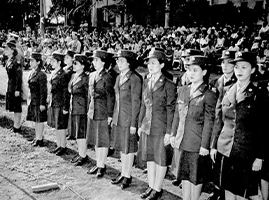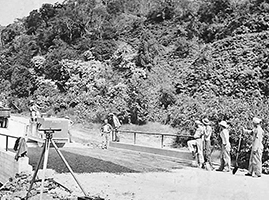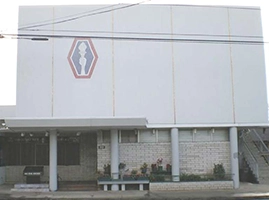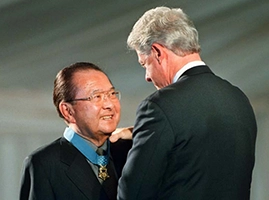During World War II, the 100th Infantry Battalion and 442nd Regimental Combat Team fought in several major campaigns in France, Italy and Germany, both as a collective force and separately. The heroics of these two Nisei combat units are deemed to this day to be among the standout military achievements in US history.
“You fought not only the enemy, but you fought prejudice — and you won. Keep up that fight, and we will continue to win — to make this great republic stand for just what the Constitution says it stands for, the welfare of all the people, all the time.” — President Harry Truman to Nisei troops, July 18, 1946
What's particularly remarkable about the accomplishments of the 100th and 442nd is that they went to battle amid a time of great hostility toward Americans of Japanese Ancestry (AJAs). Over 100,000 fellow Japanese Americans on the west coast had been incarcerated in remote internment camps and the United States had classified them as “enemy aliens,” raising widespread suspicions of their loyalty to their own country.
With this backdrop, Nisei soldiers in the 100th Infantry Battalion landed at Salerno, Italy on September 22, 1943, steely determined to prove themselves in battle and demonstrate with blood sacrifice their loyalty as Americans.
With a mission of fighting through fortified German defensive lines, the 100th quickly developed a reputation as a courageous, effective unit that took bold steps to attack and win against strong enemy resistance.
Sgt. Shigeo “Joe” Takata of Hawaii became the first Nisei soldier in the 100th to be killed in action on September 26, 1943, when he was hit by shrapnel but was able to reveal enemy gun locations. He was posthumously awarded a Purple Heart and the Distinguished Service Cross.
This is how the War Department described the 100th Battalion’s early days of combat: “While acting as advance guard…the battalion advanced fifteen miles in twenty-four hours, operating day and night in the face of strong enemy resistance and over difficult terrain... although suffering casualties, their advance continued on... all weapons were used with complete assurance.”
This determination assured the 100th’s success in its first major mission in early October 1943 — capturing Benevento, an important rail center and road intersection in Italy. The 100th was part of the 133rd Infantry Regiment under the 34th Infantry Division.
In late October and early November in 1943, the 100th crossed the cold, rapidly flowing Volturno River in three different places, braving intense German fire and minefields, suffering heavy casualties, and creating a path to attack the German defensive line at Monte Cassino.
Monte Cassino
Monte Cassino was a critical point in the Gustav Line, a string of heavily defended fortifications that ran across the Italian peninsula from sea to sea. The Germans believed that here they could halt Allied advancement through Italy.
An ancient and world famous monastery stood atop Monte Cassino. On the slopes below, Germans had unobstructed views of approaching Allied troops, while the Rapido River with its deep mud lakes posed a treacherous obstacle for anyone attempting to make a crossing. To reach the monastery, Allied soldiers starting in January 1944, had to make their way across open fields with no cover, landmines, mud, and knee-deep cold water; cross a swift-moving river; and climb the steep, 1500-foot peak of Monte Cassino.
It was during this harrowing mission that the 100th earned its name of the “Purple Heart Battalion.” The unit arrived in Europe with 1,300 Nisei soldiers. After Monte Cassino fell on May 17, 1944, the 100th was down to 521 men. There were more than 50,000 Allied casualties in the battles to breach the Gustave Line at Monte Cassino.
Because of its depleted ranks, the 100th began to receive its first replacements from the 442nd Regimental Combat Unit. The first two groups of replacements joined the 100th in the spring of 1944, bringing the battalion strength up to 1,095 soldiers.
Breakthrough at Anzio
On March 26, 1944, prior to the fall of Monte Cassino, the replenished 100th Battalion landed at Anzio, Italy, to help defend the beachhead against determined German attacks. A victory at Anzio and Mount Cassino would clear the way for the Allies to reach Rome.
More information was needed about the enemy, prompting Lt. Young-Oak Kim, a Korean American born in Los Angeles, and Irving Akahoshi from the 100th to volunteer for the mission. The two Asian American soldiers launched a daring raid, capturing two German soldiers who provided vital information that enabled Allies to break out of Anzio and head to Rome. For their bravery, both Kim and Akahoshi received the Distinguished Service Cross.
In June 1944, the 100th and five heavy weapons units were sent to clear out German troops near Lanuvio, the last enemy stronghold on the way to Rome. The 100th accomplished the task on June 3. But seven miles from Rome, they were ordered to remain at the roadside while other troops marched by — a controversial development that some attributed to racial prejudice. Rome was liberated on June 4, but the men of the 100th were not allowed to take part in the heroes' welcome.
After the fall of Rome, the 100th was sent to Civitavecchia, Italy, where they were attached to the newly arrived 442nd Regimental Combat Team.
Capture of Belvedere
One of the first battles as a combined Japanese American regiment, was the capture of the strongly held town of Belvedere on June 26, 1944. With the 2nd and 3rd battalions stalled in a frontal attack, the 100th was sent in a flanking attack to cut off the Germans from behind. The Germans were caught by surprise and in just three hours, the 100th seized the town and destroyed an entire SS battalion. They were awarded the Presidential Distinguished Unit Citation, the highest award for a military unit.
The 100/442nd continued their march up the west coast of Italy, capturing many high ground positions held by the Germans, forcing them to retreat from Livorno (Leghorn). The 100th was assigned to occupy and guard Livorno (Leghorn), which was to become an important supply port for the Allied attacking forces. Subsequently, the 100/442nd took a much needed rest and was reorganize to officially include the 100th as the first battalion of the 442nd RCT. Because of their stellar combat record, the 100th was allowed to retain its name, which it has held through all the subsequent wars to this day.
The combined regiment then returned to the line and conducted a highly successful assault crossing of the Arno River on the line between Pisa and Florence. This was to be the last action in Italy since at the highest levels of command, the Army had decided to pull the 442nd (along with other units) out of Italy and send them into southern France. The very first unit of the 442nd to engage in the invasion was the Antitank Company. It took part in the airborne invasion, landing in gliders behind the German lines; its mission — to defend the paratroop units from enemy tanks.
Subsequently, in late September 1944, the 442nd RCT departed Italy by LST (Landing Ship Tank) and went ashore near Marseilles, France, joining the 36th Division of the 7th Army. By truck and rail car, the regiment moved 500 miles north to join the battle line near the border with Germany in the Vosges Mountains. Having trained in the pine forests and swamps of Mississippi and Louisiana, they had become mountain fighters in Italy. But these mountains were densely covered by thick forests
On October 15, the 442nd RCT entered the Battle of Bruyères in the Vosges Mountains. After fierce fighting, Nisei soldiers captured Bruyères. The fighting with desperate Germans continued unabated, with the 442nd RCT liberating Biffontaine and several other towns from the Nazis. The regiment was then pulled out of the line for a needed rest from intense fighting they been through. But almost immediately they were thrown back into the battle to rescue the “Lost Battalion” of Texans from the 141st Regiment.
Rescue of the Lost Battalion
Of all the battles Nisei troops fought during World War II, the Rescue of the Lost Battalion is the most celebrated. The dramatic rescue was featured in the 1951 film, “Go for Broke!” and is considered one of the most notable World War II military achievements.
The drama unfolded in France's Vosges Mountains at the end of October 1944. The 442nd RCT was ordered to rescue a battalion of the 141st Texas Regiment, who were surrounded by German troops with limited food and water amid freezing temperatures. Two other units had attempted the mission but failed. Adolf Hitler had ordered his Nazi troops to defend the area to the last man.
To complete the mission, the men of the 442nd had to travel miles through rain and mud and densely forested mountain terrain, fighting tenaciously to break through the German lines. After harrowing, nonstop combat for six days, the Nisei soldiers reached the Lost Battalion on October 30, rescuing the remaining 211 men. The mission however, came at an enormous cost to the men of the 442nd. Combined with the battles before the Lost Battalion, the 442nd suffering almost 2000 casualties, including men killed or wounded severely. It was down to half strength. Some companies almost ceased to exist: I Company was down to 4 men and L Company to 15.
Mutt Sakumoto, the first Nisei to reach the trapped soldiers, offered a cigarette to the men of the 36th when he encountered them. Major Claude D. Roscoe of the 141st Regiment remembered his reaction after seeing the rescuers: “To our great pleasure it was members of the 442nd Combat Team. We were overjoyed to see these people for we knew them as the best fighting men in the ETO.”
The unit received a Presidential Unit Citation for their actions during the rescue; Barney Hajiro, James Okubo and George Sakato were each awarded the Medal of Honor; and nearly every soldier involved earned a Purple Heart and Bronze Star. Texas Gov. John Connally also named members of the 100th/442nd “Honorary Texans” in 1962. In years to come the Texas delegation to Congress played a key role is obtaining statehood for Hawaii, acknowledging the blood debt to be honored.
After fighting through the Vosges Mountains, the Nisei soldiers were ordered to the Maritime Alps and the French Riviera to patrol the French-Italian border. With little or no fighting taking place, they rested and regained their strength before returning to the battle to defeat Nazi Germany. But which battles would they fight?
Gen. Mark Clark, commanding the 15th Army Group in Italy, wanted the 442nd back for the final breakthrough of the Gothic Line and capture of northern Italy. However, Gen. Patch, commander of the 7th Army and under whose command the 442nd had made history with their valiant defeat of the Nazis in the Vosges Mountain, wanted the 442nd back under his command for the final battles in Germany. The decision was made at the highest level of the U.S. Army, General Marshall — the 442nd less their 522nd Field Artillery Battalion was set back to Gen. Clark for the final battles in Italy. The 522nd went to Gen. Patch for the coming battles to crush the Nazi forces in the German homeland.
In April 1945, in what was intended by the high command as a “diversionary attack,” the 442nd broke through the Gothic line in northern Italy. They pressed the attack aggressively, chasing the German forces out of the mountains and into the Po Valley in a total rout. Lead elements of the 442nd made it all the way to Turin. Combined with the subsequent breakthrough by the main Allied forces and capture of Bologna, the German Army in Italy surrendered on 2 May, almost a week before the final end of the war in Europe on May 8.
Meanwhile, the 522nd participated in the breakthrough of the Siegfried Line, crossing the Rhine River at midnight 17 March. With its well-earned reputation for speed of movement and highly accurate shooting, it became a “Roving Battalion,” moving from one Division to another depending on where the battles were being fought in the drive to capture all of southern Germany. After it participated in the capture of Mannheim and Heidelberg, it was teamed up with a Cavalry unit and raced ahead of the Infantry. At the “point of the spear,” it had experiences that were not the norm for artillerymen. They captured many German prisoners, liberated French prisoners of war, and most famously, liberated at least one slave labor subcamp of the Dachau complex and intercepted the infamous “Dachau Death March” saving thousands of Jewish prisoners from death at the hands of the Nazi SS.
In seven weeks of combat in Germany, the 522nd advanced 617 miles, almost to the Austrian border, firing 15,219 rounds in 52 displacements, and bringing freedom to thousands who had been enslaved in Nazi concentration camps.
Accolades
With their distinguished record of World War II heroics, the 100th Battalion combined with the 442nd Regimental Combat Team became the most decorated unit for its size and time in combat in the history of the U.S. Army, receiving 21 Medals of Honor, over 18,000 individual decorations, and seven Presidential Unit Citations.
After returning to the United States, President Harry Truman ordered a special parade for the 442nd in Washington, DC, praising their valor and achievements:
“You fought, not only the enemy, but you fought prejudice, and won.”

Shigeo “Joe” Takata

Monte Cassino battlefield

Bringing in German prisioners

100/442nd on tour in Italy

U.S. Troops enter Rome

100/442nd capture Livorno

100th Battalion becomes part of 442nd RCT

442nd Anti-tank Company invades southern France by air
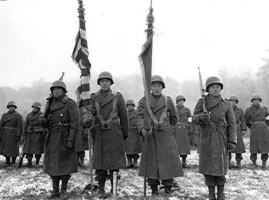
442nd stands review after victory in the Vosges

442nd Aid Station in the Vosges Mts

German soldiers surrender in droves to the 442nd
Japanese American Heroes — World War II Documentary
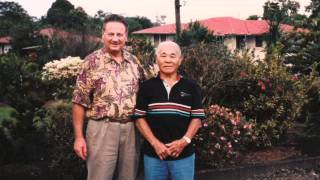
Events (Sept 1943 – Apr 1945)
100th Infantry Battalion lands at Salerno, Italy, and enters combat Sept. 29; Sgt. Joe Takata of Hawaii is first Nisei killed in action; awarded Distinguish Service Cross posthumously.
Battle of Monte Cassino; ends May 18; 100th Infantry Battalion engaged; heavy casualties reduces the 100th from 1,300 soldiers to 521.
100th Infantry Battalion lands at Anzio to assist in defending the beachhead against determined German attacks.
Liberation of Rome, with 100th Infantry Battalion participation.
442nd RCT arrives in Italy and then moves north to land by LST at Anzio. It then joins with the 100th Infantry Battalion and enters first combat near Suvereto on June 26, 1944.
100th/442nd defeats German forces on the hill protecting Livorno (Leghorn), forcing the enemy to evacuate the city. On July 19, the 100th is assigned to occupy and guard the city, while the remainder of the regiment continues the attack north to the Arno River. The 100th then moves forward and takes control of Pisa. The first week of Sept. the regiment makes an assault crossing of the Arno River, continuing to drive the Germans north. Shortly afterward the 442nd is withdrawn from the line to prepare to join in the attack in southern France.
The 100th Battalion, which until now has been attached or detached from the 442nd as the situation dictates, officially becomes the 1st battalion of the 442nd Regimental Combat Team, but is allowed to retain its original name, the 100th, in recognition of its valor and great achievements in combat with the enemy.
442nd Antitank Company takes part in the airborne invasion of southern France. Main body of 442nd RCT lands near Marseille on Sept. 29–30, 1944 and prepares for movement north to the front lines.
442nd RCT liberates Bruyères Oct. 18 and Biffontaine Oct. 23.
442nd RCT rescues 1st Battalion, 141st Infantry of Texas — the “Lost Battalion” — near Biffontaine.
442nd RCT key in Allied success in breaching Gothic Line in northern Italy.
PHOTOS COURTESY OF:
U. S. Army Signal Corps
U. S. Army Signal Corps
U. S. Army Signal Corps
U. S. Army Signal Corps
U. S. Army Signal Corps
U. S. Army Signal Corps
U. S. Army Signal Corps
U. S. Army Signal Corps
U. S. Army Signal Corps
U. S. Army Signal Corps
U.S. Department of Defense
U.S. Department of Defense
U. S. Army Signal Corps
U. S. Army Signal Corps
U. S. Army Signal Corps
U. S. Army Signal Corps
U. S. Army Signal Corps
U. S. Army Signal Corps
U. S. Army Signal Corps
U. S. Army Signal Corps
U. S. Army Signal Corps


